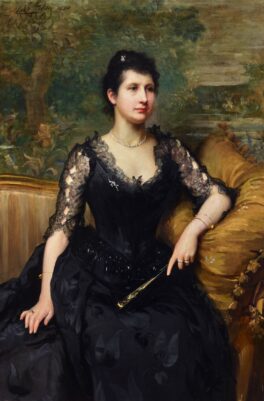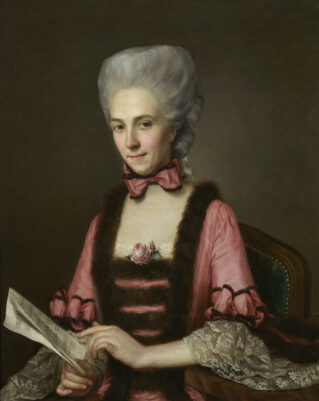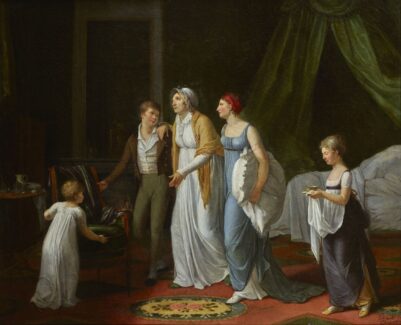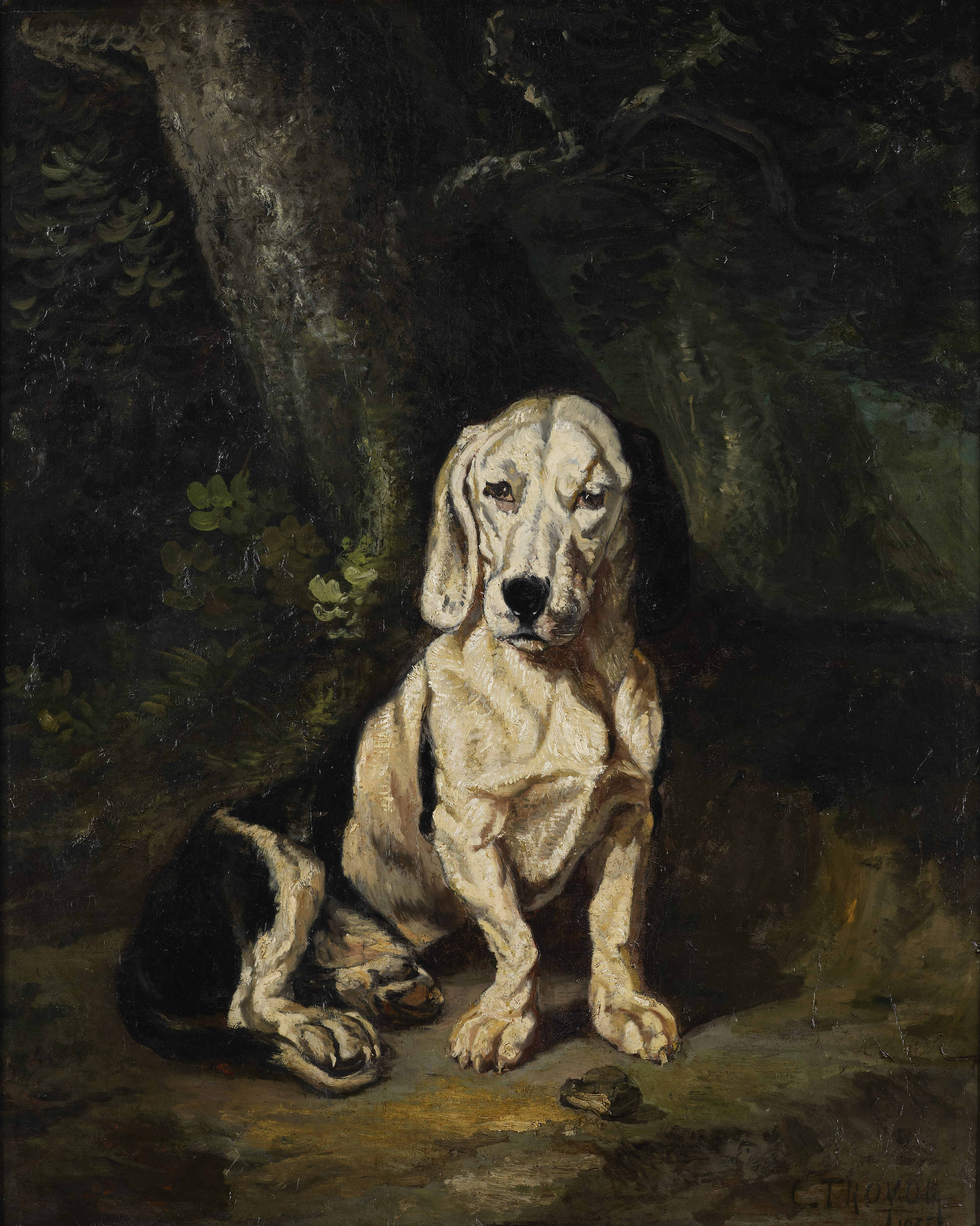
Constant Troyon
A seated basset hound
Provenance:
Maurice Boudot-Lamotte (1878-1958), Paris.
Thence by descent.
Sale, Christie’s, Paris, 23 June 2009, lot 138.
Private collection.
Sale, Sotheby’s, New York, 3 November 2015, lot 41, when acquired by the present owner.
Bibliography:
Boime, A. Art in an Age of Civil Struggle, 1848-1871. Chicago: London University of Chicago Press, 2008.
Hustin, A. Constant Troyon. Paris: Librairie de l’art, 1893.
Secord, W. Dog Painting: 1840-1940. A Social History of the Dog in Art. Woodbridge: Antique Collector’s Club, 2002.
Spurling, H. The Unknown Matisse: the Early Years, 1869-1908. Berkeley: University of California Press, 1998.
Tinterow G., and H. Loyrette. Origins of Impressionism. New York: Metropolitan Museum of Art, 1994.
Catalogue Entry
Constant Troyon was one of the most prominent animaliers – or artists specialised in animal subjects – in mid-nineteenth-century France. Born in Sèvres in 1810 into a family of porcelain painters, Troyon started his career in the famous Sèvres manufactory, where he decorated porcelain products with landscapes and natural motifs. In the 1830s, the artist met the French painters Théodore Rousseau and Jules Dupré, and later began frequenting the Barbizon school. At that time, Troyon started creating landscapes through direct observation of nature and light effects. In 1847, the painter travelled to Holland, where he was struck by Netherlandish seventeenth-century art, particularly landscapes and animal paintings. Thereafter, animals became the major subject in Troyon’s oeuvre, leading him to gain international success.1 Works by the artist are today in the collections of major museums worldwide, such as the Musée d’Orsay in Paris, the Edinburgh National Gallery and the Metropolitan Museum of Art in New York.
A seated basset hound is one of the finest examples of Troyon’s activity as an animal painter. At the centre of the composition sits a dog, confronting the viewer with its gaze. Its crooked front legs and short, bi-coloured coat allow to identify it as a basset hound. The dog is depicted in the middle of a forest, as suggested by the dark green vegetation and two oblique tree trunks in the background. On the lower right, written on the rocky ground, are the artist’s signature and the year of execution, 1855.
The specific reasons which led Troyon to create A seated basset hound are unknown today. The date 1855 suggests that Troyon might have painted it in the Touraine region of the Loire Valley, where, since the previous year, he had spent the summer visiting his artist friend Léon Félix Loysel. On these occasions, Troyon executed several paintings of hunting dogs. Considering that basset hounds were originally bred for hunting because of their developed sense of smell, the subject of the present work might have been one of Loysel’s dogs. Nevertheless, its stillness differs significantly from the way in which dogs appear in other paintings executed by Troyon at Loysel’s. These animals are usually depicted while performing an action, as it happens, for example, in the famous Hound Pointing (Fig.1), today at the Boston Museum of Fine Arts.2 On the contrary, the basset hound’s staged stance is closer to that of a person rather than an animal, making the work resemble a portrait. The sympathetic individuality of Troyon’s sitter, also conveyed by its tender yet proud gaze, suggests that the work might have been specifically commissioned by a patron. Indeed, by the mid-nineteenth century, it had become common among the European aristocracy and upper bourgeoisie to commission established artists to portray their favourite animals, especially dogs.3

Fig. 1. Constant Troyon, Hound Pointing, 1860, oil on canvas, 163.8 x 130.5 cm., Museum of Fine Arts, Boston
Constant Troyon found his vocation as an animal painter through the encounter with seventeenth-century Dutch painting. In 1847, during a trip to Holland, Troyon probably saw works by Netherlandish artists dedicated exclusively to dogs, such as, for example, Paulus Potter’s Wolfhound (Hermitage Museum, Moscow, Fig. 2). The French artist might have borrowed from Potter the idea of presenting a seated dog frontally, as exemplified by the dog on the right in Cat playing with two dogs (Philadelphia Museum of Art, Philadelphia, Fig. 3).
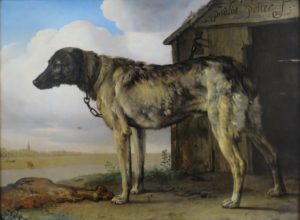
Fig. 2. Paulus Potter, Wolf Hound, 1650-52, oil on canvas, 97 x 132 cm., Hermitage Museum, Saint Petersburg.

Fig. 3. Paulus Potter, Cat playing with two dogs, 1652, oil on canvas, 92.7 x 109.2 cm., Philadelphia Museum of Art, Philadelphia.
The present work also attests Troyon’s knowledge of the masters of his own time, particularly Gustave Courbet (1819-1877). In 1855, Troyon participated in the Paris Salon and possibly saw the forty canvases that the French Master exhibited at the “Pavillion du Réalisme.”4 Through the encounter with Courbet’s oeuvre, Troyon developed the ability to capture material facts through a palpable use of pigment. Indeed, at a close look, the basset hound’s coat feels accessible to the touch. Stylistically, the realistic rendering of the tree trunks and foliage, along with their earthly colours are also reminiscent of Courbet’s work (Fig. 4) and, simultaneously, of the forests painted by the Barbizon artists. A seated basset hound also demonstrates Troyon’s exceptional command of light effects. The painting’s subject is illuminated frontally, as if it were on a stage, while the vegetation around it is brightened up through sudden light reflections. With all this considered, quoting Claude Monet’s words on Troyon’s oeuvre, the present canvas can be indeed considered “admirable.”5

Fig. 4. Gustave Courbet, The Stream (Le Ruisseau du Puits-Noir; vallée de la Loue), 1855, oil on canvas, 104 x 137 cm., National Gallery of Art, Washington.
A seated basset hound was originally in the collection of the French painter Maurice Boudot-Lamotte (1878-1958), who was a pupil of animal painter Philibert Léon Couturier and later studied under Gustave Moreau. A friend of Pierre-Albert Marquet, Paul Signac and Henri Matisse, he was an intimist painter of landscapes, still lives and portraits, and later became an art collector.6 Another painting by Troyon is known to have belonged to Boudot-Lamotte’s collection: Lisière de bois, Forêt en Automme, which was originally believed to be a work by Théodore Rousseau.7
1 For a detailed biography of Constant Troyon, see A. Hustin, Constant Troyon, (Paris: Librairie de l’art, 1893). 2 Museum of Fine Arts Boston. Last accessed, 24 September 2018: https://www.mfa.org/collections/object/hound-pointing-32153 3 For a detailed study see, W. Secord, Dog painting: 1840-1940. A Social History of the Dog in Art, (Woodbridge: Antique Collector's Club, 2002). 4 A. Boime, Art in an Age of Civil Struggle, 1848-1871, (Chicago: London University of Chicago Press, 2008), 211. 5 G. Tinterow and H. Loyrette, Origins of Impressionism, (New York: Metropolitan Museum of Art, 1994), 464: “It would be impossible to describe to you the beautiful things I saw there [in Troyon’s studio]: admirable cows and dogs.” 6 H. Spurling, The Unknown Matisse. A Life of Henri Matisse: the Early Years, 1869-1908, (Berkeley: University of California Press, 1998), p. 436, note 57. 7 MUDO - Musée de l'Oise. Last accessed, 6 October 2018, http://mudo.oise.fr/en/the-collections/the-19th-century-collection/oeuvre/constant-troyon-lisiere-de-bois-foret-en-automne/
Condition:
Under UV inspection, sparse dots of inpainting can be detected throughout the composition, especially on the dog’s rear paws. The signature appears to have been reinforced. Overall, the work is in very good condition and no major damages or repairs are visible. The canvas has been lined.
